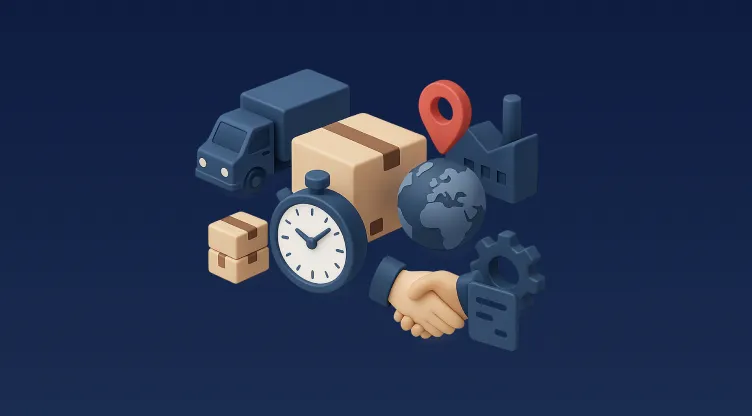Introduction
Efficient transportation management is the backbone of modern supply chains. Businesses, particularly in the MENA region, face challenges such as increasing fuel costs, last-mile delivery inefficiencies, and unpredictable traffic conditions. Transportation Management Systems (TMS) offer a solution by leveraging route optimization algorithms to create shorter, more efficient delivery paths.
In this article, we’ll explore how advanced route optimization models in a TMS system can revolutionise logistics, reduce costs, and enhance customer satisfaction. Whether you are a retailer, distributor, or 3PL provider, these insights will help you understand how leveraging TMS meaningfully transforms supply chain efficiency.
Understanding TMS and Route Optimization
What is a TMS System?
A Transportation Management System (TMS) is a logistics platform that helps businesses plan, execute, and optimise the movement of goods. It provides real-time tracking, automation, and analytics to streamline supply chain operations.
TMS Meaning in Logistics
In logistics, a TMS system is crucial for optimising delivery routes, reducing transportation costs, and improving fleet efficiency. It integrates with Warehouse Management Systems (WMS), Order Management Systems (OMS), and external carriers to ensure smooth logistics execution.
What is Route Optimization in TMS?
Route optimization is the process of identifying the fastest, most cost-efficient delivery path using data-driven algorithms. It considers factors like:
- Traffic congestion
- Weather conditions
- Fuel consumption
- Vehicle capacity
- Delivery time windows
- Real-time road conditions
By applying AI-powered algorithms, modern TMS solutions ensure smarter, cost-effective delivery routes.
Advanced Route Optimization Models in TMS
To achieve maximum efficiency, businesses are turning to cutting-edge route optimization models integrated into modern TMS platforms. Here are some of the most advanced ones:
1. Dynamic Route Optimization
Traditional route planning is often static, meaning routes are predetermined before dispatch. However, Dynamic Route Optimization adjusts in real-time based on traffic updates, road closures, and delays.
How It Works:
- GPS and IoT sensors track vehicle movement.
- AI-powered analytics predict potential delays.
- Routes are recalculated in real-time to ensure faster deliveries.
🔹 Example: If a driver encounters heavy congestion in Riyadh, the TMS system can reroute them automatically to a faster alternative, reducing delivery time.
2. AI-Based Predictive Analytics for Route Planning
AI-driven TMS solutions can predict delivery patterns and optimise routes based on historical data. Predictive analytics use:
- Machine learning models
- Traffic pattern analysis
- Weather forecasting
- Fleet performance data
Benefits:
✅ Minimises unnecessary stops
✅ Reduces fuel consumption
✅ Optimises delivery schedules
🔹 Example: An e-commerce retailer in Dubai can pre-plan weekend delivery routes based on previous order volumes, ensuring optimal fleet allocation.
3. Cluster-Based Route Planning
Cluster-based optimization is ideal for multi-drop deliveries, where orders are grouped geographically to minimise backtracking.
Key Features:
- AI-based clustering of orders in the same zone.
- Fewer miles driven per delivery round.
- Reduces wear and tear on vehicles.
🔹 Example: A last-mile delivery company in Abu Dhabi can group deliveries by district, ensuring that drivers complete all orders in one area before moving to the next.
4. Load-Balancing Algorithms
Fleet efficiency is not just about shorter routes but also about optimal vehicle loading. Load-balancing algorithms ensure:
- Proper weight distribution across vehicles.
- Maximum utilisation of truck space.
- Minimised number of trips.
🔹 Example: A logistics provider in Saudi Arabia can optimise pallet arrangements to ensure balanced weight distribution, avoiding unnecessary fuel expenses.
5. Time-Window Optimization
Many businesses operate under strict delivery schedules. A TMS with time-window optimization ensures:
- Priority-based route selection (e.g., VIP clients get early deliveries).
- Compliance with restricted delivery times in urban areas.
- Penalty avoidance for late deliveries.
🔹 Example: A grocery chain in Kuwait that must deliver perishable items within a 2-hour window can rely on AI-driven scheduling algorithms.
6. Geofencing and Real-Time Alerts
Geofencing technology in a TMS system helps monitor driver behaviour and ensure compliance with predefined delivery zones.
How It Works:
- Creates virtual boundaries around delivery areas.
- Sends real-time alerts when a vehicle enters or exits the area.
- Enhances security by tracking unauthorised route deviations.
🔹 Example: A pharmaceutical distributor in Egypt can prevent unauthorised detours, ensuring medicines reach hospitals on time.
Key Benefits of Advanced Route Optimization in TMS
1. Reduced Fuel and Transportation Costs
By selecting shortest, most efficient routes, businesses can cut fuel consumption by up to 20%.
2. Faster Delivery Times
AI-driven route planning ensures deliveries are on time, improving customer satisfaction.
3. Enhanced Driver Productivity
Drivers spend less time on the road, allowing them to complete more deliveries per shift.
4. Lower Carbon Emissions
Efficient routes mean less fuel burned, reducing carbon footprint—a key factor for sustainability-focused businesses.
5. Improved Last-Mile Efficiency
With real-time tracking, businesses can adapt dynamically to last-mile delivery challenges, ensuring seamless logistics execution.
How Omniful TMS Enhances Route Optimization
Omniful’s AI-powered TMS integrates real-time tracking, predictive analytics, and automated route planning to help businesses enhance logistics efficiency. Some key features include:
✅ Automatic order batching for optimised delivery routes
✅ AI-powered fleet tracking for real-time adjustments
✅ Dynamic route recalculation to avoid delays
✅ Automated time-window scheduling for high-priority orders
✅ Integration with sales channels and marketplaces for seamless order fulfilment.
Omniful has been instrumental in helping retailers, 3PL providers, and e-commerce businesses in MENA optimise delivery logistics and reduce operational costs.
Final Thoughts
TMS route optimization algorithms are revolutionising logistics by making deliveries faster, cost-effective, and more reliable. Businesses adopting AI-powered route planning models experience reduced transportation expenses, improved fleet efficiency, and greater customer satisfaction.
For companies operating in MENA’s competitive supply chain environment, investing in a robust TMS system like Omniful can future-proof logistics operations.
🚀 Looking to optimise your delivery routes with AI-driven TMS? 📩 Get in touch with Omniful today to see how our TMS can help you cut costs and enhance efficiency!.
FAQs
1. What is the meaning of TMS in logistics?
TMS stands for Transportation Management System, a software solution that optimises route planning, fleet tracking, and delivery management.
2. How does a TMS system optimise routes?
TMS uses AI-driven algorithms, real-time traffic data, and predictive analytics to select the fastest, most cost-efficient routes.
3. Can TMS help reduce transportation costs?
Yes. By optimising routes, reducing fuel consumption, and balancing loads, TMS can cut transportation expenses by up to 20%.
4. What industries benefit from TMS route optimization?
Retail, e-commerce, FMCG, pharmaceuticals, logistics providers, and 3PL companies benefit from AI-powered TMS solutions.
5. Is AI necessary for TMS route planning?
AI enhances route prediction, dynamic recalculation, and real-time decision-making, making logistics operations more efficient.

























